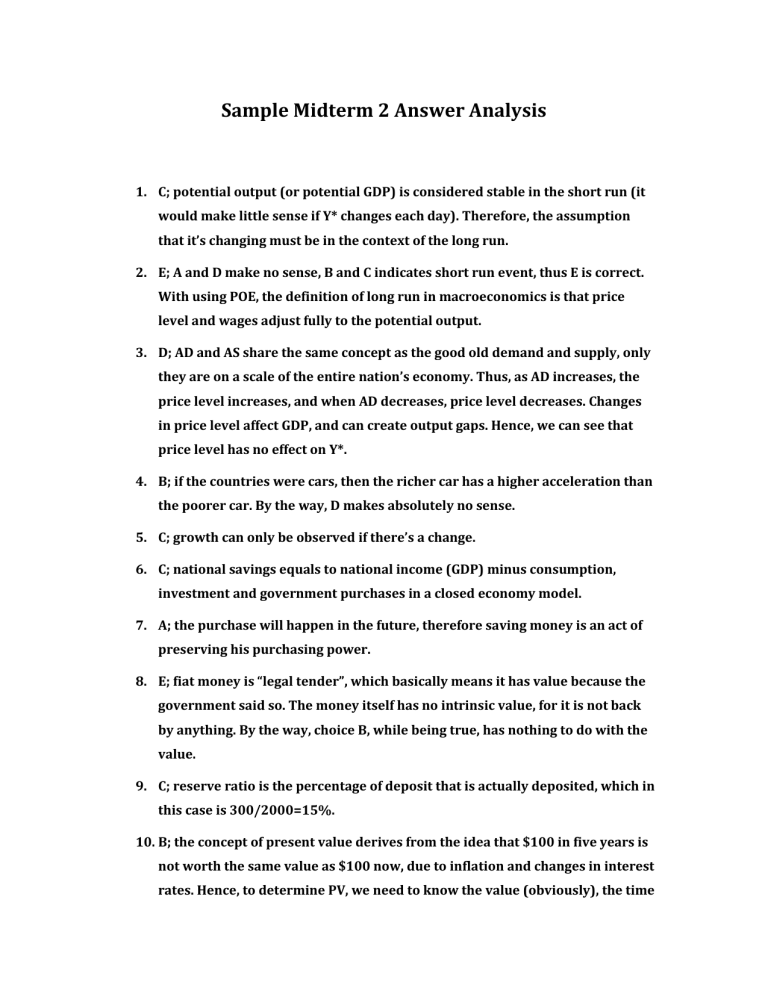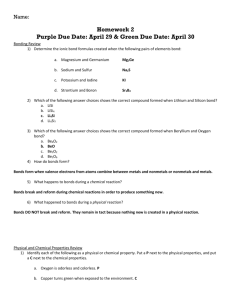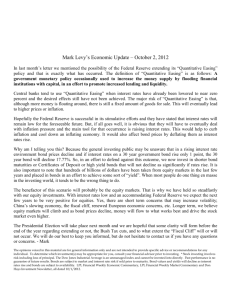2013 Spring Sample Midterm 2 Solutions

Sample Midterm 2 Answer Analysis
1.
C; potential output (or potential GDP) is considered stable in the short run (it would make little sense if Y* changes each day). Therefore, the assumption that it’s changing must be in the context of the long run.
2.
E; A and D make no sense, B and C indicates short run event, thus E is correct.
With using POE, the definition of long run in macroeconomics is that price level and wages adjust fully to the potential output.
3.
D; AD and AS share the same concept as the good old demand and supply, only they are on a scale of the entire nation’s economy. Thus, as AD increases, the price level increases, and when AD decreases, price level decreases. Changes in price level affect GDP, and can create output gaps. Hence, we can see that price level has no effect on Y*.
4.
B; if the countries were cars, then the richer car has a higher acceleration than the poorer car. By the way, D makes absolutely no sense.
5.
C; growth can only be observed if there’s a change.
6.
C; national savings equals to national income (GDP) minus consumption, investment and government purchases in a closed economy model.
7.
A; the purchase will happen in the future, therefore saving money is an act of preserving his purchasing power.
8.
E; fiat money is “legal tender”, which basically means it has value because the government said so. The money itself has no intrinsic value, for it is not back by anything. By the way, choice B, while being true, has nothing to do with the value.
9.
C; reserve ratio is the percentage of deposit that is actually deposited, which in this case is 300/2000=15%.
10.
B; the concept of present value derives from the idea that $100 in five years is not worth the same value as $100 now, due to inflation and changes in interest rates. Hence, to determine PV, we need to know the value (obviously), the time
and interest rate. By the way, the formula for calculating PV is given by
Value/(1+interest)^time.
11.
D; $100/(1+0.05)+100/(1+0.05)^2=$185.94. The formula is given in #10, just be careful that the payment comes in two parts.
12.
E; A and D are automatically wrong by the law of supply and demand. Selling bonds will only increase the money balance, thus E is correct. Dude you don’t even need to look beyond the second blank to get this question right. But if you insist to, simple and nice supply and demand would be more than enough.
On another note, the price of bonds and interest rates do not have a demand and supply relationship. Rather, if the interest rate is low, then the suppliers of bonds can jack up the price (remember, the higher the price of a bond, the lower its rate of return). This is because they would still be providing a higher rate of return than the interest rate. Likewise, if the interest rate is high, then the bonds price would decrease.
13.
C; no bank can directly influence aggregate demand or supply, for they represent the demand and supply of the entire economy. The only things and central banks/governments have control over are the money supply (how much cash to print) and the interest rate (overnight rate).
14.
C;
15.
D; the change in interest rate is the first stage of the monetary transmission mechanism. As interest rate changes, so does the expectation of people, which influences their spending patterns, thus affecting the aggregate demand, which in turn affects real GDP. As the economy of other nations is not directly affected by the interest rate, it will not change net exports. Although 3 is also correct in that changes in aggregate demand can shift the price level, 1 is more correct.
Question 1:
∆Deposits=∆New cash deposit /(c+v)
The ratio of cash drain is combined with reserve ratio in this equation because, like reserve ratio, cash drain decreases the amount of money that the bank can lend out.
Question 2:
Inflationary pressure is when the prices of things increase faster than wages, causing a decrease in people’s purchasing power. To reduce inflationary pressure, the Bank of Canada will need to reduce price level. The price level is determined by
AD and AS, but as the Bank has little direct influence in AS, it will have to reduce AD.
To do so, the Bank will increase the overnight rate, which will raise nominal and real interest rates, cause people to want to spend less.
Question 3:
Since the offered price is lower than its market equilibrium at its present value, the implied yield is greater than the market interest rate. Hence, a profitseeking individual should purchase this bond. However, also dues to its greater implied yield, the free-market mechanism will move the bond price towards the equilibrium. Hence we would expect the bond price to rise in the near future.
Question 4:
The central bank can bring the economy back to Y* from an inflationary gap by reducing money supply. This is achieved through decreasing the purchasing of government bonds on the open market, which lessens the injection of deposit in private/commercial banks. When the demands of bonds decrease, so do their prices.
Since bond price and interest rate are inversely proportional, interest rate goes up, which discourages investment expenditures. As a result, the AD curves shifts left and closes the inflationary gap.
Question 5:











